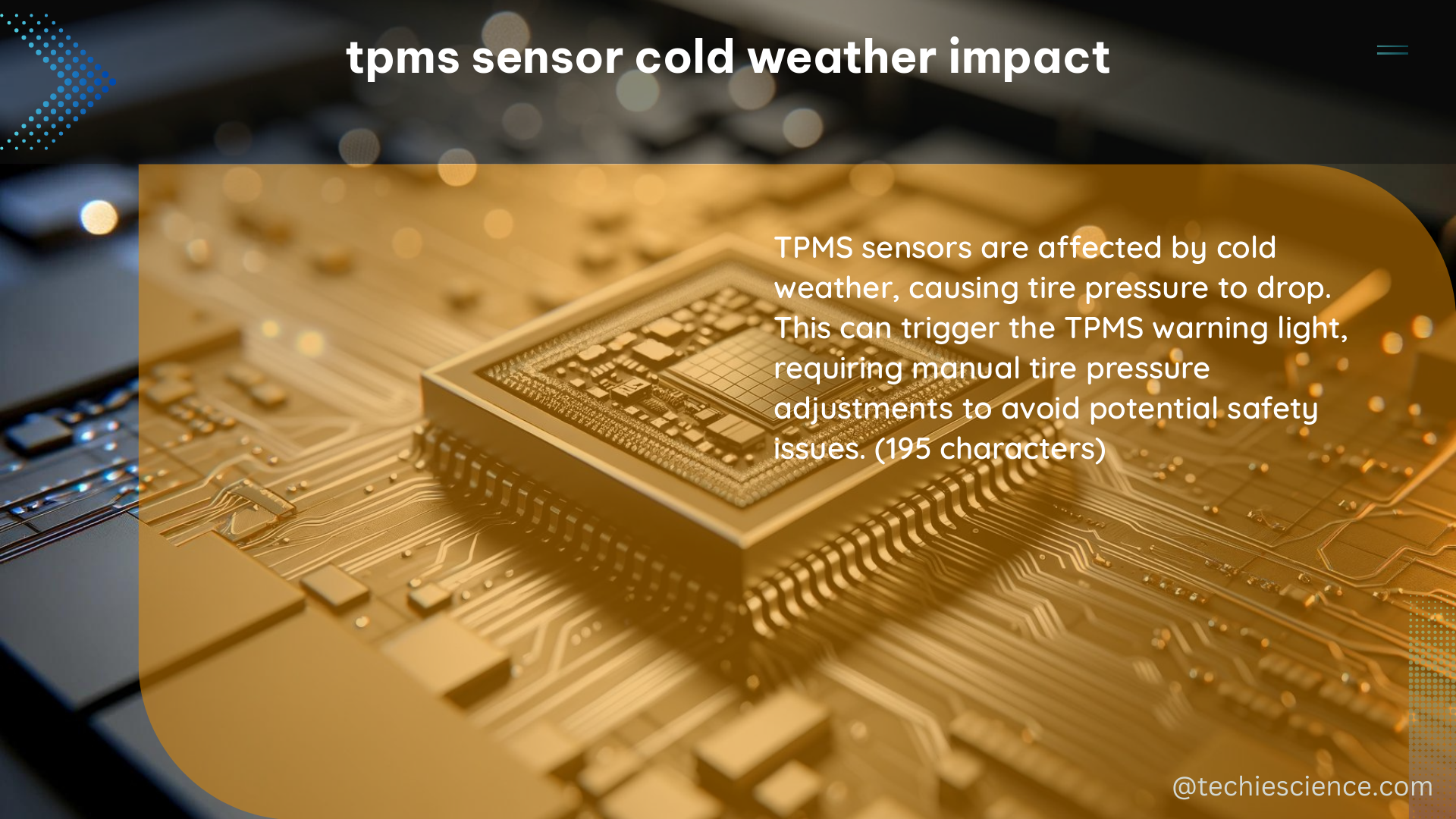TPMS (Tire Pressure Monitoring System) sensors are crucial for ensuring the safety and efficiency of your vehicle by monitoring tire pressure. Cold weather can have a significant impact on TPMS sensors, primarily by causing the air inside tires to contract, leading to lower tire pressure. This can trigger your TPMS warning light, even if there’s nothing wrong with your tires or wheels. In this comprehensive guide, we’ll dive deep into the measurable data, technical specifications, and DIY solutions to address TPMS sensor issues in cold weather.
Measurable Data on TPMS Sensor Cold Weather Impact
Tire Pressure Drop
- For every 10 degrees Fahrenheit (5.5 degrees Celsius) the temperature decreases, tire pressure can drop by approximately 1 PSI (pounds per square inch).
- This means that a 30-degree Fahrenheit (16.7 degrees Celsius) drop in temperature can cause a 3 PSI decrease in tire pressure.
TPMS Light Activation
- The TPMS light is typically triggered when tire pressure drops below the recommended fill pressure, which is usually around 32 PSI for most vehicles.
- In cold weather, the TPMS light may illuminate even if the tires are properly inflated, as the drop in temperature can cause the pressure to fall below the threshold.
TPMS Sensor Malfunction
- TPMS sensors can malfunction in cold weather, requiring a reset by a dealer or service center.
- This can be due to various factors, such as increased viscosity of the hydraulic fluid in the TPMS system or the sensors’ inability to operate effectively at the lower end of their designed temperature range.
TPMS Sensor Battery Life
- Cold weather can cause old batteries in TPMS sensors to act up, leading to sensor malfunctions.
- The typical life expectancy of a TPMS sensor battery is 5-10 years, but extreme temperatures can shorten their lifespan.
Technical Specifications of TPMS Sensor Cold Weather Impact

TPMS Sensor Technology
- TPMS sensors use pressure transducers to measure the air pressure inside each tire and transmit this information to the vehicle’s onboard computer.
- The sensors are designed to operate within a specific temperature range, typically from -40°F to 150°F (-40°C to 65°C).
Hydraulic Fluid Viscosity
- The TPMS system relies on hydraulic fluid to transmit pressure readings from the sensors to the vehicle’s computer.
- In cold weather, the viscosity of this fluid can increase, potentially affecting the sensors’ ability to accurately measure and transmit tire pressure data.
Temperature Range Limitations
- While TPMS sensors are designed to operate within a wide temperature range, their performance may be affected near the edges of this range.
- Exposure to extreme cold can cause the sensors to malfunction or provide inaccurate readings, leading to TPMS light activation or other issues.
TPMS Sensor Cold Weather Impact DIY
Regularly Check Tire Pressure
- During colder months, make it a habit to check your tire pressure regularly, as low temperatures can cause a significant drop in pressure.
- Maintain the recommended tire pressure, as specified by your vehicle’s manufacturer, to ensure optimal performance and safety.
Reset TPMS Light
- If your TPMS light comes on due to cold weather, driving your vehicle may help warm up the tires and air inside, causing the light to turn off as pressure increases.
- If the light persists, you may need to have the TPMS system reset by a dealer or service center.
Replace TPMS Sensor Batteries
- If your TPMS sensors are several years old, consider replacing the batteries to ensure optimal performance in cold weather.
- The typical life expectancy of a TPMS sensor battery is 5-10 years, but extreme temperatures can shorten their lifespan.
Visit a Dealer for TPMS Sensor Inspection
- If you suspect your TPMS sensors are malfunctioning due to cold weather, it’s best to have them inspected and reset by a dealer or service center.
- They have the necessary tools and expertise to diagnose and address any TPMS-related issues.
By understanding the measurable data, technical specifications, and DIY solutions for TPMS sensor cold weather impact, you can ensure your vehicle’s safety and efficiency, even in the harshest winter conditions.
References
- TPMS Light Coming On in Cold Weather? Here’s Why
- How Cold Weather Can Trigger Your TPMS
- TPMS in Cold Weather
- TPMS Error Only When Cold
- Can Cold Weather Cause TPMS Sensors to Malfunction?

The lambdageeks.com Core SME Team is a group of experienced subject matter experts from diverse scientific and technical fields including Physics, Chemistry, Technology,Electronics & Electrical Engineering, Automotive, Mechanical Engineering. Our team collaborates to create high-quality, well-researched articles on a wide range of science and technology topics for the lambdageeks.com website.
All Our Senior SME are having more than 7 Years of experience in the respective fields . They are either Working Industry Professionals or assocaited With different Universities. Refer Our Authors Page to get to know About our Core SMEs.